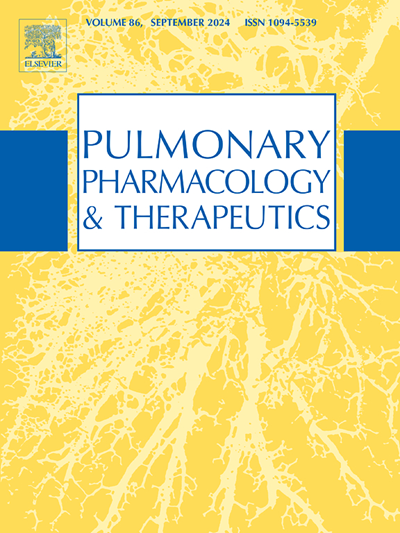PM2.5通过驱动更强的免疫反应来增强香烟引起的小鼠肺部炎症:齐墩果酸的潜在有益作用。
IF 2.8
3区 医学
Q2 PHARMACOLOGY & PHARMACY
引用次数: 0
摘要
虽然吸烟(CS)是慢性阻塞性肺病的主要危险因素,但空气污染加剧和环境空气中颗粒物(PM2.5)浓度升高在很大程度上导致了慢性阻塞性肺病病例,特别是对吸烟者而言。然而,双重暴露于CS和PM2.5的COPD发病机制尚不完全清楚。因此,我们通过小鼠模型研究了CS(9支/天,持续4天)和PM2.5(单剂量50μg)联合暴露对COPD发病机制的影响,以了解这一过程背后的关键因素。数据表明,CS预暴露小鼠的PM2.5单次暴露引发了强烈的炎症反应,其特征是从巨噬细胞炎症转变为中性粒细胞炎症,与单次暴露相比,导致肺功能严重恶化。此外,与单独暴露相比,联合暴露导致BALF中促炎细胞因子(G-CSF/KC/MCP-1/TNF-α/IL-1β/IL-6)水平的显著增加。有趣的是,正如肺组织中BALF炎症细胞,特别是中性粒细胞和各种氧化应激标志物(如ROS/LPO/GSH/SOD/过氧化氢酶)的数据所反映的那样,OA治疗可能通过发挥抗氧化特性来保护抗CS+ pm2.5诱导的copd样肺部炎症。抑制炎症与下调促炎因子IL-1β、TNF-α、mmp -2基因表达及蛋白酶-抗蛋白酶平衡正常化有关,其途径是下调MMP-9基因表达,同时上调其抑制剂TIMP-1。OA治疗后炎症反应的减少与肺功能的改善密切相关。总体而言,PM2.5暴露会加剧cs诱导的与COPD相关的肺部炎症,而OA可以有效改善这种炎症。本文章由计算机程序翻译,如有差异,请以英文原文为准。
PM2.5 augments cigarette smoke-induced lung inflammation in mice by driving a stronger immune response: Potential beneficial effects of oleanolic acid
Though cigarette smoke (CS) is primary risk factor for Chronic obstructive pulmonary disease (COPD), rising air pollution and higher concentrations of particulate matter (PM2.5) in ambient air contribute substantially to COPD cases, particularly in smokers. However, the pathogenesis of COPD upon dual exposure to CS and PM2.5 is not entirely known. Therefore, the impact of combined exposure to CS (9 cigarettes/day for 4 days) and PM2.5 (single dose of 50 μg) on COPD pathogenesis was examined using mouse model in order to understand the key players behind the process. The data suggest that single exposure to PM2.5 in CS pre-exposed mice triggered a strong inflammatory response, marked by switch from macrophage to neutrophilic inflammation, leading to severe deterioration in lung function compared to single hits. Furthermore, combined exposure led to robust increase in the levels of pro-inflammatory cytokines (G-CSF/KC/MCP-1/TNF-α/IL-1β/IL-6) in BALF as compared to the respective individual exposure. Interestingly, Oleanolic acid (OA) treatment protects against CS + PM2.5-induced COPD-like pulmonary inflammation potentially by exerting antioxidant properties as reflected by data on BALF inflammatory cells, particularly neutrophils and various oxidative stress markers such as ROS/LPO/GSH/SOD/Catalase in lung tissue. Suppressed inflammation was associated with downregulation of gene expression of pro-inflammatory factors namely IL-1β, TNF-α, MIP-2 and normalization of proteinase-antiproteinase balance by downregulating gene expression of MMP-9 with simultaneous upregulation of its inhibitor TIMP-1. Reduced inflammatory response upon OA treatment correlates well with improved lung function. Overall, PM2.5 exposure flares up the CS-induced lung inflammation linked to COPD, which is effectively ameliorated by OA.
求助全文
通过发布文献求助,成功后即可免费获取论文全文。
去求助
来源期刊
CiteScore
6.20
自引率
0.00%
发文量
41
审稿时长
42 days
期刊介绍:
Pulmonary Pharmacology and Therapeutics (formerly Pulmonary Pharmacology) is concerned with lung pharmacology from molecular to clinical aspects. The subject matter encompasses the major diseases of the lung including asthma, cystic fibrosis, pulmonary circulation, ARDS, carcinoma, bronchitis, emphysema and drug delivery. Laboratory and clinical research on man and animals will be considered including studies related to chemotherapy of cancer, tuberculosis and infection. In addition to original research papers the journal will include review articles and book reviews.
Research Areas Include:
• All major diseases of the lung
• Physiology
• Pathology
• Drug delivery
• Metabolism
• Pulmonary Toxicology.

 求助内容:
求助内容: 应助结果提醒方式:
应助结果提醒方式:


